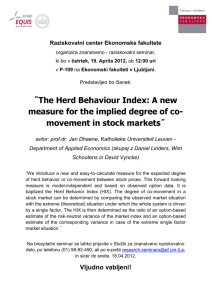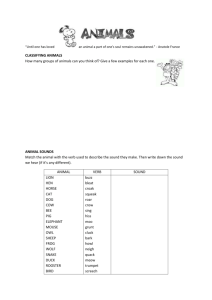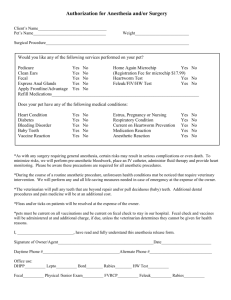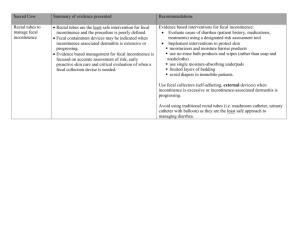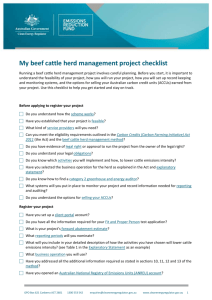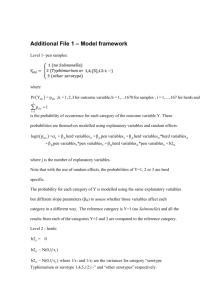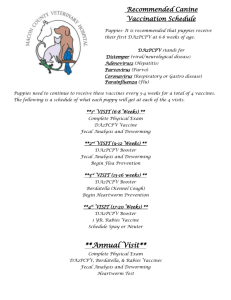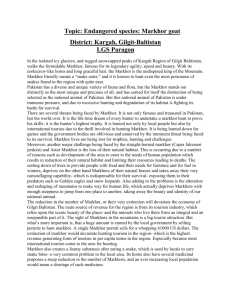Samuel Glickman paper 2014
advertisement
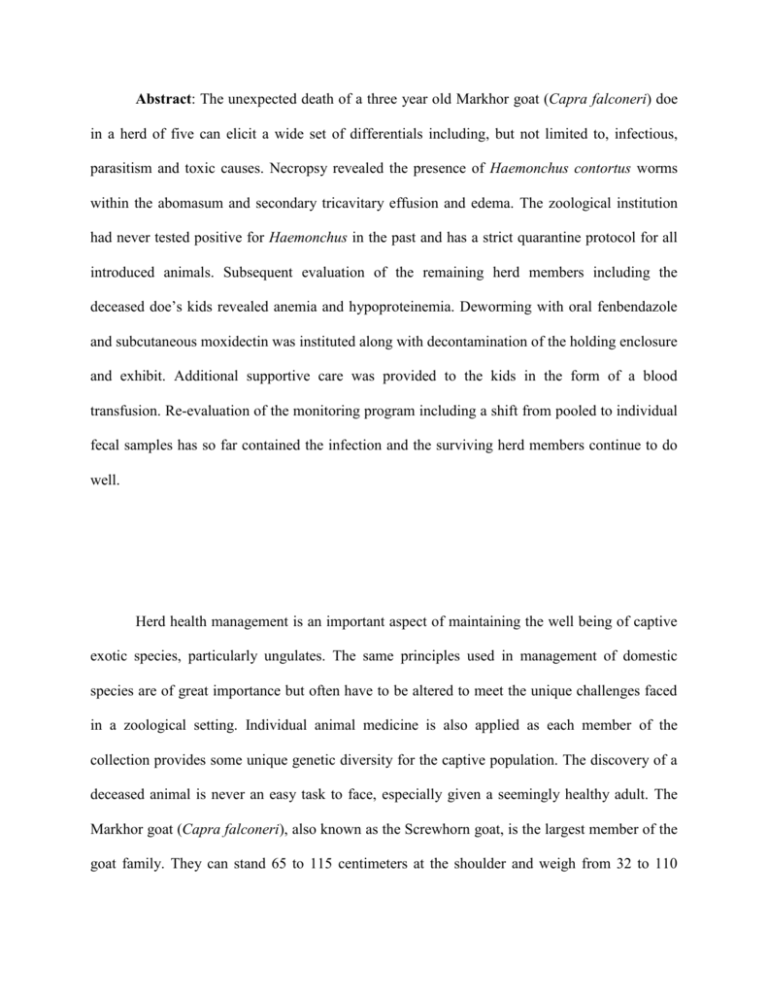
Abstract: The unexpected death of a three year old Markhor goat (Capra falconeri) doe in a herd of five can elicit a wide set of differentials including, but not limited to, infectious, parasitism and toxic causes. Necropsy revealed the presence of Haemonchus contortus worms within the abomasum and secondary tricavitary effusion and edema. The zoological institution had never tested positive for Haemonchus in the past and has a strict quarantine protocol for all introduced animals. Subsequent evaluation of the remaining herd members including the deceased doe’s kids revealed anemia and hypoproteinemia. Deworming with oral fenbendazole and subcutaneous moxidectin was instituted along with decontamination of the holding enclosure and exhibit. Additional supportive care was provided to the kids in the form of a blood transfusion. Re-evaluation of the monitoring program including a shift from pooled to individual fecal samples has so far contained the infection and the surviving herd members continue to do well. Herd health management is an important aspect of maintaining the well being of captive exotic species, particularly ungulates. The same principles used in management of domestic species are of great importance but often have to be altered to meet the unique challenges faced in a zoological setting. Individual animal medicine is also applied as each member of the collection provides some unique genetic diversity for the captive population. The discovery of a deceased animal is never an easy task to face, especially given a seemingly healthy adult. The Markhor goat (Capra falconeri), also known as the Screwhorn goat, is the largest member of the goat family. They can stand 65 to 115 centimeters at the shoulder and weigh from 32 to 110 kilograms. Markhor are sexually dimorphic, with males having longer hair on the chin, throat, chest and shanks. Females are redder in color, with shorter hair, a short black beard, and. Both sexes have tightly curled, corkscrew-like horns which close together at the head, but spread upwards towards the tips. Markhors are native to the Middle East and Indian subcontinent which includes India, Afghanistan, Uzbekistan and Pakistan. They are primarily a mountainous species (altitudes of 600-3600 meters) and will seasonally migrate up and down the mountains as the season changes (Nowak 1999) Currently, Markhor goats are listed as Appendix I species under CITES (Convention on International Trade in Endangered Species). This designation is for endangered species and prohibits international trade. The major threats to the Markhor include illegal harvesting (for both meat and horns for medicinal purposes), habit degradation, fragmentation and competition with domestic livestock. Keepers discovered the body of the three year old Markhor goat during morning duties. The doe was one of five adults and two kids in the collection. In the days prior her discovery the keepers had noticed that she was lethargic and had some swelling of the lower jaw and eyes. The herd had a history of Eimeria and some strongyles based on group pooled fecal samples. Treatment had included levamisole and pyrantel. Differentials for acute death in a doe can include toxin ingestion, trauma from a herd mate, high parasite load with secondary anemia and hypoproteinemia, renal injury following myoglobinuria secondary to capture myopathy/stress and acute bacterial infections particularly Clostridial infections among other things. As the body was discovered on a day that the zoo veterinarians were not on site the decision was made to submit the body for necropsy and to evaluate the herd the next day. Gross necropsy results included diffuse submucosal edema with abundant intraluminal nematode parasites and moderate amounts of serous tricavitary effusions. In addition, the subcutis contained a diffuse moderate 2 edema. Based on the gross finding the diagnosis was severe haemonchosis with hypoproteinemia and anemia. Haemonchosis is the infestation of the abomasum of domestic sheep and goats by the nematode worm of the genus Haemonchus, particularly Haemonchus contortus, also known as the red stomach worm or barber's pole worm. Adult worms attach to the abomasal mucosa and feed on blood. Clinical signs include anemia, hypoproteinemia which can manifest itself as bottle jaw, emaciation, failure to thrive and sudden death. Unlike other gastrointestinal parasites Haemonchus does not cause diarrhea and thus can be overlooked. H. contortus has been isolated from various species of bovids and cervids, both domestic and wild. Management consists of routine fecal egg counts, deworming the most affected individuals and pasture rotation. However, many of these strategies can be difficult in the zoological setting due to limitations of space, prevalence of mixed species exhibits and limited knowledge of specie specific pharmacokinetics of the commonly used anthelmintics. This is further complicated by the rise in anthelmintic resistance (Hoberg et al 2001; Getachew 2007). The life cycle of Haemonchus is similar to that of most strongyles. Infective L3 larvae, ingested by the host on pasture, develop into adults in the abomasum and produce eggs that are passed in the feces. The eggs hatch in the feces and undergo two molts, becoming L3 larvae that can migrate up blades of grass in drops of moisture. Under the proper conditions (humidity and high temperatures) it may only take a few days for an egg deposited in feces to develop to the L3 stage. A single adult female worm can produce approximately 5,000 eggs a day and infected animals can contain hundreds to thousands of worms. Coupled with the short life cycle (less than 3 weeks) pasture contamination is rapid and a herd can find itself in cycle of infectioncontamination-reinfection. This is further exacerbated by prolonged L3 larvae survival on 3 pasture under the proper environmental conditions (up to 6 months). Adult worms only survive several months in the host by undergoing a hypobiotic state (Kaplan 2005). Diagnosis of haemonchosis is usually based on clinical signs and fecal flotation results. As anemia is the principle clinical problem, observation of mucous membrane color has become the standard monitoring method. The FAMACHA system uses a 5-point scale to gauge ocular mucous membrane color, which correlates with packed cell volume in sheep. This same technique has been employed in goats and other exotic ruminants. Typically animals scoring a 3 or worse receive the proper anthelmintic. Selective treatment based on severity of affected animal. The advantage of the FAMACHA system is that it allows for the combating of resistance by treating only the most severely affected animals and remove low level selective pressure (vanWyk 2002). The major downside in a zoological setting is the system requires evaluation of each individual and thus capture of the all herd member. As with any procedure involving captive wild animals the risks and benefits of any interaction and treatment must be weighed. Most affected animals with clinical Haemonchosis have high fecal egg counts of up to 10,000 eggs per gram. However, the two main issues is the long prepatent period (time between infection with the parasite and shedding of eggs) and the inability to differentiate Haemonchus eggs from other strongyle eggs on fecal flotation. Parasitology laboratories can culture larvae from parasite eggs to speciate the nematode but the lag time can be fatal. A more recent test is the unique staining property of Haemonchus eggs with flouroscein stain. Although few labs have the capability this test may become more mainstream in the future. Treatment involves identification of affected individuals, decontamination of all enclosure via removal of organic material including feces and the treatment with anthelmintics. 4 Some of the more common drugs include Levamisole (7.5 mg/kg), Fenbendazole (5 mg/kg), Ivermectin (0.2 mg/kg) and Moxidectin (0.2-0.4 mg/kg). Increasingly more veterinarians are facing the prospect of drug resistance in the worm population (Kaplan 2005, Vokral et al 2002, Young et al 2000). Mechanisms behind the development of resistance include overtreatment with the same medication, treatment of non-clinical individuals and incomplete delivery or dosage of the anthelmintics. Within the zoo setting there have been few studies on the efficacy of the typical anthelmintics within the various species and thus the true impact of resistance is not known. With the presumptive diagnoses achieved the decision was made to begin the evaluation of the rest of the herd. Each adult was captured separately in chute and a brief physical exam and jugular blood draw were performed. The adults all had pink to pale pink mucous membranes with no signs of hypoproteinemia. In house blood examinations revealed low to normal packed cell volume (PCV) and total solids (TS) based on ISIS reference ranges for the species. As the previous monitoring protocol was based on pooled fecal samples, an effort was made to collect individual fecal samples for quantitative egg analysis. The adults were also started on a two day course of oral fenbendazole (10 mg/kg). Once the full necropsy report had returned and consultation was made with both a parasitologist and expert in sheep and goat medicine (Dr. Mary Smith of Cornell University’s College of Veterinary Medicine) a new protocol was drafted. All animals were removed from the exhibit area and subsequent decontamination (removal of plant material and feces) was initiated. Individual quantitative fecal egg count were collected routinely and if egg count returned as greater than 500 eggs/gram the affected individual was to be started on fenbendazole (10 mg/kg) for 2 days and one dose of moxidectin (0.4 mg/kg).Once the egg counts were reduced by 90% the individual returned to the exhibit. Based on the new 5 protocol, all of the adults were recaptured two days after the initial examination. Again the mucous membranes were evaluated for each adult and were similar to the previous examination. Additional treatment was administered in the form of subcutaneous selenium (BoSe at 0.06 mg/kg) and a subcutaneous dose of moxidectin (0.4 mg/kg). Additional blood samples were collected for full complete blood counts (CBC) and chemistry panels. The completed bloodwork returned as unremarkable for all of the adults. As mentioned previously the collection also included the two kids of the deceased doe (approximately 3 months of age). As they were still young enough for manual restraint to be effective and safe, the kids were evaluated separately the first day. Their mucous membranes were much paler than the adults. In house examination of their blood reveal anemia (PCV 22% and 16%). Additional blood samples were submitted for CBC and chemistry and revealed a regenerative anemia (anisocytosis, polychromasia) in each kid. Before the results were back each kid was given an injection of intramuscular iron (10 mg/kg) to help support hematopoietic process. Due to their anemia, young age and value to the captive population a discussion into the possibility of an in-house transfusion was discussed. As the staff at the time had seen exotic ungulates succumb to Haemonchus in a very rapid fashion along with their young age the decision was made to attempt a whole blood transfusion. A major and minor crossmatch was performed using blood collected from the two adults with the highest PCV values. No signs of agglutination or hemolysis were observed macroscopically or microscopically. The transfusion was planned for the next day and the Cornell Blood and Coagulopathy lab was consulted in regards to amount of blood to administer along with technique. Using the formula: Donor blood(mL) = 80 x BW(kg)x (Desired PCV-Recipient PCV)/ (PCV of transfused blood), one unit of blood (500 mL) was collected in CPDA-1 bag from the largest buck. Each kid was manually 6 restrained by the keeper staff in their holding pen and a 16G jugular catheter was placed in the left jugular vein. As only one bag was collected the transfusion was performed in succession with a new filtration system for each kid. The desired amount was delivered via serial weighing of the bag and using the density of blood (1.06 g/mL blood). The weight of the bag along with the respiratory and heart rates of the kids was recorded every three minutes. No adverse reactions were observed during the transfusion and the kids were administered oral fenbendazole (10 mg/kg). The kids were observed the rest of the day for any potential transfusion reactions of which none were seen. Two days later the PCV results were rechecked and returned as improved (38% and 27%). In accordance with the new plan they were also administered a subcutaneous dose of moxidectin (0.4 mg/kg). Since the placement of the new monitoring and treatment plan the herd has had no further problems associated with haemonchosis. Subsequent individual fecal egg counts have revealed low levels of strongyle eggs and none of the herd members have appeared clinically anemic. The main question still left unanswered was the source of the Haemonchus. All individuals within the herd underwent a quarantine process including fecal egg counts prior to introduction to the herd and no other animals at the zoo had ever tested positive for Haemonchus. The main theory at this time is that the adult worms may have been in a hypobiotic state in the doe and underwent a periparturient rise following kidding. The short life cycle of the worm coupled with the proper environmental conditions produced substantial contamination and worm burden in the herd. Additionally, monitoring had been in the form of pooled fecal samples and may have underestimated the true individual worm burden. Regardless of the origin this episode revealed several points of weakness in the monitoring programs that were corrected. As with any population management, constant vigilance and reevaluation of the normal are essential. 7 References Getachew, T., P. Dorchies, and P. Jacquiet. “Trends and Challenges in the Effective and Sustainable Control of Haemonchus contortus Infection in Sheep. Review.” 2007. Parasite 14: 3-14. Hoberg, E.P., A.A. Kocan, and L.G. Rickard. “Gastrointestinal Strongyles in Wild Ruminant” 2001. Faculty Publications from the Harold W. Manter Laboratory of Parasitology. Paper 623. Kaplan, R.M. “Responding to the Emergence of Multiple-Drug Resistant Haemonchus contortus: Smart Drenching and FAMACHA.” Proceedings of the Kentucky Veterinary Medical Association 2005 Morehead Clinic Days Conference, June 4-5, 2005. Nowak, R. “Walker’s Mammals of the World, 6th ed.” Baltimore: John Hopkins University Press, 1999. Van Wyk, J.A. and G.F. Bath. “The FAMACHA system for managing haemonchosis in sheep and goats by clinically identifying individual animals for treatment.” 2002. Vet Res. 33: 509-529. Vokral, I, et al. “The Metabolism of flubendazole and the activities of selected biotransformation enzymes in Haemonchus contortus strains susceptible and resistant to anthelmintics.” 2012. Parasitology 139: 1309-1316. 8 Young, K.E., M.S. James, J.M. Jensen, and T.M. Craig. “Evaluation of Anthelmintic Activity in Captive Wild Ruminants by Fecal Egg Reduction Tests and a Larval Development Assay. ” 2000. Journal of Zoo and Wildlife Medicine 31(3): 348-352. 9
![Samuel Glickman ppt 2014 [Microsoft PowerPoint]](http://s2.studylib.net/store/data/009922291_1-eab3fcd51bbb6aacefd702f5e7823100-300x300.png)
